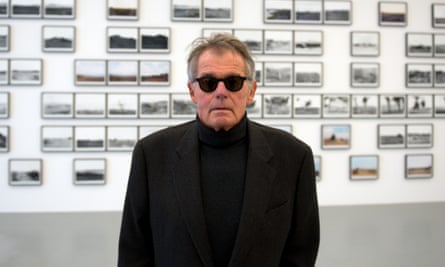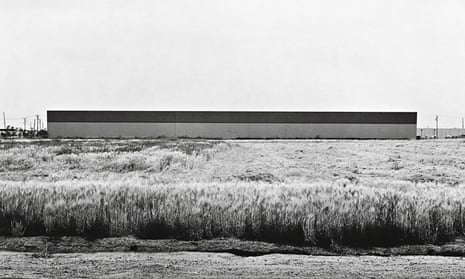Lewis Baltz, whose austere, monochrome images of suburban development helped to redefine American landscape photography in the early 1970s, has died of complications of cancer and emphysema, aged 69. Baltz was one of a group of photographers whose shared aesthetic – minimalist, detached, dispassionate – drew on contemporary art practice and rejected the romanticism of traditional landscape photography. It became known as the New Topographics movement. Its subject was the impact of the city on the American wilderness, and the increasing homogenisation of the suburbs.
The photographers came together for an influential exhibition, New Topographics: Photographs of a Man-Altered Landscape, at the George Eastman House in Rochester, New York, in 1975. Its curator, William Jenkins, noted their “stylistic anonymity”, linking it to the detached point of view employed by Ed Ruscha in his photobooks, Twentysix Gasoline Stations (1962) and Every Building on the Sunset Strip (1966).
Of the eight photographers selected by Jenkins, who included Robert Adams, Stephen Shore and Frank Gohlke, Baltz’s style was the most stark, his subject matter the most ordinary: concrete walls, garages, vast industrial warehouses, metal fire escapes, anonymous buildings, an absence of people. “I was looking for the things that were most typical,” he said later, “the things that were the most quotidian, everyday, unremarkable, and trying to represent them in the way that was the most quotidian, everyday and unremarkable.”
Baltz’s minimalism was manifest in a series of enduringly influential photobooks, including The New Industrial Parks Near Irvine California (1974), San Quentin Point (1986) and Candlestick Point (1989).

Born in Newport Beach, California, Baltz was an only child. His parents ran a mortuary service and his father was the local deputy coroner. Baltz first became interested in photography, aged 14, when he began working in a camera shop in Laguna Beach. He later attended the San Francisco Art Institute, graduating in 1969. For his master’s degree thesis, he submitted a series of images of tract houses – sprawls of identical properties built on often vast swaths of land that were a defining feature of American urbanisation at the time. It set the tone for what was to follow.
From the start, Baltz saw himself as an artist. “I never saw myself as a photographer,” he said. “I never liked photography very well. I never felt any allegiance to its so-called history ... I made photographs because photography was the simplest, most direct way of recording something.”
Growing up in southern California in the postwar years, he had witnessed at first hand the rapid urbanisation of the countryside and the relentless spread of suburbia. “You could watch the changes taking place and it was astonishing,” he recalled. “A new world was being born ... this new homogenised American environment that was marching across the land. And it seemed no one wanted to confront this; it was invisible.” His images, for all their anti-style, possessed a stark, geometric beauty, making visible this new homogenised America in a way that echoed – and criticised – the soullessness of urban planning and the corporate rationale that lay behind it.
In 1975, the Leo Castelli gallery published an edition of Baltz’s seminal The New Industrial Parks Near Irvine, California, signalling the photographer’s entry into the conceptual art world. Two years later, his photographs were shown at the Whitney Biennial in New York. In the late 1980s, Baltz moved to Europe, where his work fitted into the lineage of austere postwar landscape photography that had begun with Bernd and Hilla Becher and the Dusseldorf School. (The Bechers, who made grids of black and white prints of looming industrial water tanks and silos, had been the only European photographers included in the original New Topographics show at George Eastman House.)
By then, Baltz was shooting in colour and, long before it became accepted practice in the conceptual photography world, was making large-scale prints. He was interested, he said, in representing “the generic European city”. Out of this grew a fascination with digital technology and its uses, not least in surveillance and control. In 1992, he created the monumental Ronde de Nuit installation at the Pompidou Centre in Paris, a series of images printed on Cibachrome panels that together measured 2.1m (7ft) high and 11.9m (39ft) across. Its subject was surveillance sites and those who operated them, the images being taken from surveillance camera footage or made to resemble it.
Though his style shifted from the low-key to the epic, becoming ever more political, he remained preoccupied with the impact of industrialised buildings on the environment, and on the culture and society they grew out of and, in turn, helped to shape.
In 2002, Baltz was made professor of photography at the European Graduate School, Saas-Fee, Switzerland. He also lived and worked for a time in Venice, before moving to Paris. Over the years, his work has been acquired by leading museums and galleries including the Guggenheim, the Museum of Modern Art in San Francisco and Tate Modern.
Baltz remains an influential artist, whose concerns, aesthetic and political, resonate throughout photography, in an age when the digital image has become ubiquitous and the meaning of photography contested. “I certainly wanted my work to look like anyone could do it,” he said of his approach. “I didn’t want to have a style. I wanted it to look as mute and as distant as to appear to be as objective as possible, but of course it’s not objective.” Therein lies its enduring power.
He is survived by his wife, the artist Slavica Perkovic, and daughter, Monica.

Comments (…)
Sign in or create your Guardian account to join the discussion